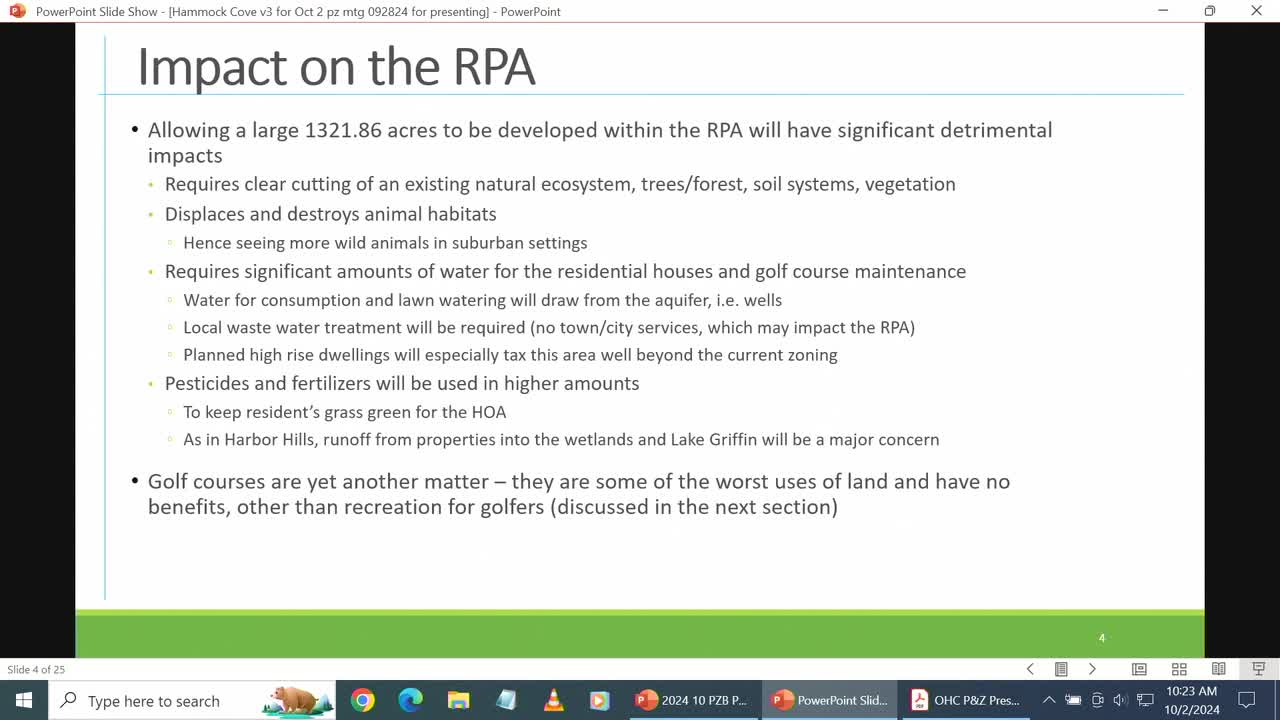Concerns rise over golf courses harming local wetlands
October 02, 2024 | Lake County, Florida
This article was created by AI summarizing key points discussed. AI makes mistakes, so for full details and context, please refer to the video of the full meeting. Please report any errors so we can fix them. Report an error »

In a recent government meeting, significant concerns were raised regarding the environmental impact of proposed developments in Lake County, particularly in relation to water consumption, runoff, and the proliferation of golf courses. Experts highlighted that the increasing presence of wild animals in suburban areas is linked to the high water demands of residential properties and golf courses, which could exacerbate local water shortages.
The discussion centered on the need for local wastewater treatment solutions as high-density housing developments are planned, which would place additional strain on existing resources. The current zoning allows for one dwelling unit per five acres, but proposals for more intensive development could lead to detrimental effects on local ecosystems, particularly in the sensitive areas surrounding Lake Griffin and the Ocklawaha River.
Concerns were also voiced about the use of pesticides and fertilizers, which are necessary for maintaining residential lawns and golf courses. The runoff from these properties poses a significant threat to nearby wetlands and conservation areas, potentially harming local wildlife and habitats.
The meeting also addressed the proposal for a new golf course within the old Hammock Cove property, which would be located less than a mile from an existing golf course. Critics argued that the addition of another golf course is unnecessary and would further contribute to habitat degradation. Golf courses are known to be among the worst land uses for local ecosystems, primarily serving recreational purposes while offering little ecological benefit.
Furthermore, the concept of an \"Audubon certified\" golf course was scrutinized. Participants clarified that Audubon International, which offers this certification, is not affiliated with the National Audubon Society, raising questions about the credibility and ecological benefits of such certifications.
Overall, the meeting underscored the need for careful consideration of environmental impacts in planning and zoning decisions, particularly in areas designated for conservation. The community is urged to prioritize sustainable development practices that protect local ecosystems and ensure a balance between human activity and nature.
The discussion centered on the need for local wastewater treatment solutions as high-density housing developments are planned, which would place additional strain on existing resources. The current zoning allows for one dwelling unit per five acres, but proposals for more intensive development could lead to detrimental effects on local ecosystems, particularly in the sensitive areas surrounding Lake Griffin and the Ocklawaha River.
Concerns were also voiced about the use of pesticides and fertilizers, which are necessary for maintaining residential lawns and golf courses. The runoff from these properties poses a significant threat to nearby wetlands and conservation areas, potentially harming local wildlife and habitats.
The meeting also addressed the proposal for a new golf course within the old Hammock Cove property, which would be located less than a mile from an existing golf course. Critics argued that the addition of another golf course is unnecessary and would further contribute to habitat degradation. Golf courses are known to be among the worst land uses for local ecosystems, primarily serving recreational purposes while offering little ecological benefit.
Furthermore, the concept of an \"Audubon certified\" golf course was scrutinized. Participants clarified that Audubon International, which offers this certification, is not affiliated with the National Audubon Society, raising questions about the credibility and ecological benefits of such certifications.
Overall, the meeting underscored the need for careful consideration of environmental impacts in planning and zoning decisions, particularly in areas designated for conservation. The community is urged to prioritize sustainable development practices that protect local ecosystems and ensure a balance between human activity and nature.
View full meeting
This article is based on a recent meeting—watch the full video and explore the complete transcript for deeper insights into the discussion.
View full meeting